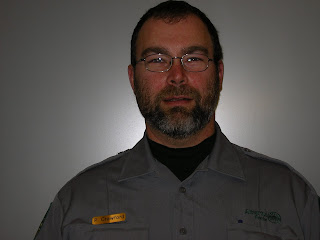In May of 1973 Ray started work as a Park Officer Trainee at Cypress Hills. After Cypress Ray went on to Sir Winston Churchill Provincial Park. Ray moved in February, when he departed Cypress Hills a Chinook was blowing and the temperature was + 15, when Ray arrived at Sir Winston Churchill the temperature was - 45, as Ray looked out through the ice fog covering the lake he started to wonder where he had moved to.
After about a year at Sir Winston Churchill Ray moved further north to Gregoire Lake. When Ray arrived at Gregoire Lake there were no phone lines, there was a mobile phone that was set up in the staff house. A large horn was on the outside of the house went off when an incoming call occurred. If you were in the office you had to run to the house when the horn announced an incoming call. During the summer month when the nearby firetowers were manned you could call them and get them to contact their radio room in Ft. McMurray. This was how emergency services were called to assist with emergencies in the campground.
After Gregoire Lake Ray moved to Long Lake where his two Children Lance and Helena were born. Many a summer evening was spent canoeing and/or fishing with his children. After Long Lake Ray moved to Whitney Lakes where he first became exposed with contracts. The Ross Lake Campground was one of the first campgrounds to have a private operator.
Ray then took a minor career change and became the Resource Coordinator for the Cold Lake District (at that time area offices were called district offices). When the Cold Lake District Office closed Ray moved to Red Deer. By this time Ray had realized that being in the office was not for him. Reorganization gave Ray a chance to get back into the field where he spent two years in the Red Deer District being involved with Aspen Beach, Sylvan Lake, Red Lodge and associated Provincial Recreation Area.
Ray then moved to Peace River to become the District Team Leader for the Peace River District. Ray arrived just in time for the Lac Cardinal Rodeo which was an eye-opener. Ray jumped into the management and operation of the Wildland Parks - the canoe patrol of the Chinchaga Wildland and the snowmobile patrols in Caribou Mountains Wildland and the Peace River Wildlands are an enjoyable addition to Ray’s duties.
Ray was actively involved in the Hay-Zama twinning ceremony with the Dali Lake Nature Reserve in Mongolia China and the addition of a Conservation Officer and the opening of an office in High Level.
Ray is very proud of his years of service with Alberta Provincial Parks and his contributions to their enjoyment by Albertans and their guests, and his contributions to preserving Alberta’s natural environments.







